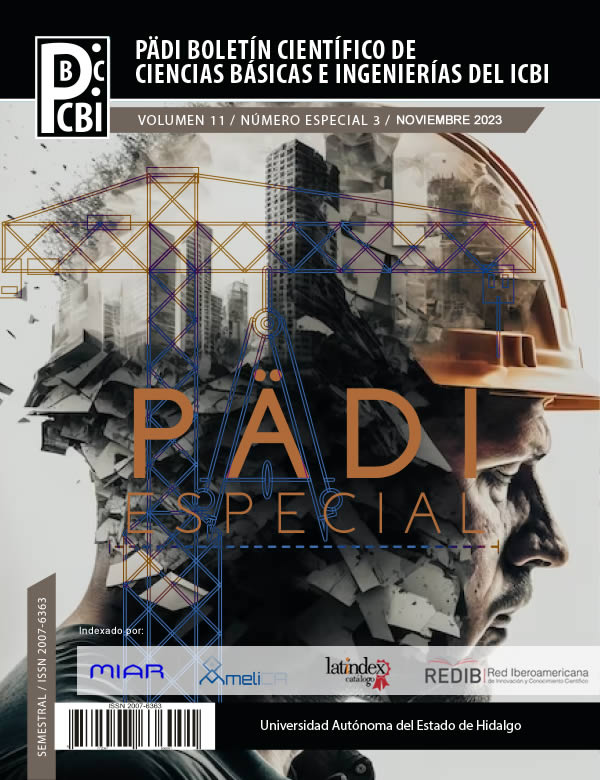Anti-desertification: sustainable urban drainage systems (SUDS) as integral management in the regulation and control of rainwater
Abstract
Poor water management is a problem that plagues the State of Hidalgo, causing shortages in various areas. It is known that of the 158 WWTP (Wastewater Treatment Plants) that exist in the state, only 85 of them are operating, according to the Institutional Development Program of the State Water and Sewerage Commission (PID 2017-2022). This situation encourages to fail to meet the demand for water to a population in constant disorderly growth. Added to this, the presence of rainy conditions that present overflows due to silting generates negative effects on society. This work proposes sustainable urban drainage systems as rainwater management techniques to support urban development, controlling runoff in the urban environment, seeking to reduce the amount of water in the final discharge and its use as a water supply for green roofs. Proposing solutions for integrated water cycle management and use of rainwater harvesting systems. To carry out this work, theoretical and experimental information was compiled, making use of contemporary studies and manuals on the application of these systems around the world, which allowed proposing an integral hydroponic design, with the enrichment of rainwater with nutrients, provided through a process of columns filled with residual stone materials. The proposed system was evaluated, and the results showed an optimal integral development, with accelerated growth in the hydroponic plants evaluated due to the nutrients incorporated into the rainwater through the design proposal.
Downloads
References
Ballester-Olmos y Anguís, J.F., Peris-García, P.P., Soto-Fernández, R., Andrés‐Doménech, I., Escuder Bueno, I. (2015). El Agua en Benaguasil. Un viaje en el tiempo. Ayuntamiento de Benaguasil. Depósito legal: V-1817-2015.
Bayo, J., López-Castellanos, J., Rojo, M. D., & Olmos, S. (2018). Emisión de microplásticos desde estaciones depuradoras de aguas residuales:¿ son los polímeros más demandados los más encontrados en nuestros efluentes. Conama 2018.
Birtles, P., Dahlenburg, J. (2012). All roads lead to WSUD: exploring the biodiversity, human health and social benefits of WSUD.
Castro-Fresno, Daniel & Andrés-Valeri, Valerio & Sañudo-Fontaneda, Luis & RodriguezHernandez, Jorge. (2013). Sustainable Drainage Practices in Spain, Specially Focused on Pervious Pavements. Water. 5. 67-93. 10.3390/w5010067.
Cely-Calixto , N. J. . (2022). Propuesta de un sistema urbano de drenaje sostenible para reducir los niveles de inundación en la ciudad de Cúcuta, Colombia. Eco Matemático, 13(2), 6–17. https://doi.org/10.22463/17948231.3529.
De Desastres, C. N. D. P. (s. f.). 70 años de la gran inundación en Pachuca, Hidalgo. gob.mx. Https://www.gob.mx/cenapred/articulos/70-anos-de-la-gran-inundacion-en-pachuca-hidalgo
Doménech i. Andrés (2017). Una apuesta decidida por el drenaje urbano sostenible. Agua y medio ambiente. El economista (46), 20-21.
García, á. F., & prieto-thomas, a. (2013). Integración de sistemas urbanos de drenaje sostenible en la rehabilitación del espacio urbano. Greencities & sostenibilidad: málaga, 2-3 oct 2014 : inteligencia aplicada a la sostenibilidad urbana : comunicaciones y 2a bienal de proyectos de edificación y urbanismo sostenible, 2014, isbn 978-84-697-0799-9, págs. 291-313, 291-313.
Gonzalez vives, c. (2012). Visualizing urban hydrology. The design of a wet surface. Mascontext: visibility. Pp. 114 - 121. 01/2012. Issn 2332-5046.
Gonzalez vives, c. (2014). Arquitectura antidesertización: fluidez, biodiversidad, hidrofilia y permeabilidad. Tesis doctoral, universidad politécnica de madrid
Gonzalez vives, c. (2014). Espacios del agua en el territorio urbanizado. Los Angeles, California. Revista europea de investigación en arquitectura. Pp. 63 - 78. 01/2014. Issn 2340-9851.
Gonzalez vives, c. (2016). Dehydrated architecture. Ivery review, columbia university press. N16
Hatt, b. E., fletcher, t. D., walsh, c. J., & taylor, s. L. (2004). The influence of urban density and drainage infrastructure on the concentrations and loads of pollutants in small streams. Environmental management, 34(1), 112 - 124. Doi: 10.1007/s00267-004- 0221-8
Morales‐torres, a., perales‐momparler, s., jefferies, c., andrés‐doménech, i. (2015). Report on stormwater management. Improvement of energy efficiency in the water cycle by the use of innovative storm water management in smart mediterranean cities.
Mondría García, M. (2011). Infrastructuras y eutrofización en l'Albufera de València. El modelo Cabhal (Doctoral dissertation, Universitat Politècnica de València).
Perales momparer s., andrés i. (2016). Retos para la integración de los sistemas de drenaje sostenible en los procesos de planificación vigentes. Ix congreso ibérico de agua y ciudad. Sistemas urbanos de drenaje sostenible 21 gestión y planificación del agua. 61-78.
Peris-garcía, p.p., perales-momparler, s. (2016). La apuesta por la infraestructura verde urbana para la gestión de pluviales tiene premio. Comunicación técnica del congreso nacional de medio ambiente, conama 2016: la respuesta es verde, 28 nov-2 dic, madrid, españa.
Green infrastructure partnership. (2015). Green infrastructure and low impact development: a planning and design guide.
Grifeu Font, J. (2018). Ciudades adaptativas y resilientes ante el cambio climático: Estrategias locales para contribuir a la sostenibilidad urbana.
Wang, x., cao, s. & chen, l. (2021). Sustainable drainage systems: a handbook for small-scale pervious urban areas.
Copyright (c) 2023 Iván Erick Castañeda-Robles, Adriana Michelle Martínez-Núñez, Maydaly Virginia Rómulo-Hernández

This work is licensed under a Creative Commons Attribution-NonCommercial-NoDerivatives 4.0 International License.













